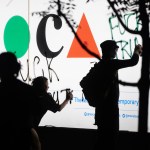The man on the building-high mural is crouched in a rap squat, his suit cut slim and feet in high-top Converse sneakers. Behind him, the word “liberty” appears as spray-painted graffiti, still dripping. A chunky watch adorns his wrist.
The hair is familiar, the gaze “majestic in his wrath,” as women’s rights activist Elizabeth Cady Stanton once called it.
There’s no mistaking Frederick Douglass — reimagined as, what, Doug E. Fresh?
The interpretation, unveiled at a recent festival in the Chesapeake tidewater hamlet of Easton, is dividing the town and fueling debate over how America redefines and reimagines its ever-present past.
Where some onlookers see a modern tribute to a consequential abolitionist and presidential adviser renowned for his fiery oration, others see an insult.
The divisions are felt deeply here in Talbot County, where a young Frederick Bailey — later Douglass — was once enslaved. Members of the Bailey family, relatives of Douglass who remained on Maryland’s Eastern Shore, say the piece is degrading.
“Have you seen the mural that has Uncle Frederick looking like some kind of street thug?” is what Tarence Bailey, 48, reported hearing from family elders the morning the mural went up. “Something needs to be done about it and it needs to come down,” said Bailey, who is the five-times-great-nephew of Douglass.
He said no one in Easton consulted the family before the mural went up. Now, community members are starting a petition and planning demonstrations to urge its removal.
“It may be legal to put it up,” Bailey said. “But it’s not respectful.”
“Frederick Douglass never wanted to be viewed as an amiable slave or viewed as a Black man on his knees,” Bailey expanded, in a statement he was still crafting as word of the mural spread.
An effort that began as one of those small-town, economic-revival public art projects, where installations accompany cute restaurants and knickknackeries that sell nautical crafts made of oyster shells, has focused attention on an essential question: Who gets to tell these stories — and how — in a country divided over what work must come down and what should rise?
Historians and teachers I interviewed drew different conclusions about the piece.
It’s “truly distasteful,” said one.
“To have Frederick Douglass come back up again, but in this positive, contemporary light is just really an awesome thing,” said another.
“What’s next, Harriet Tubman in booty shorts?” asked a third.
Reached by phone, mural artist Adam Himoff said he is motivated to make sense of the past and the present, so he placed Douglass in the context of popular Black icons today — the well-tailored suit, the watch, the sneakers, that crouch. Jay-Z, Lil’ Kim, Bill Clinton and thousands of Instagrammers pose in the #rapsquat.
“Oh, I like it,” said Marquis Taylor, a PhD student in history at Northwestern University and a Howard University trustee who recently curated a Douglass exhibit.
Taylor said it made Douglass fresh and relatable. Then I asked him if it would change his mind to know the artist is a White guy, a former finance bro who is now working as an artist.
“Wait, can I retract my statement?” Taylor laughed.
Himoff was going for that very reaction. He said he grew up as a Jewish kid in 1990s New York City, influenced by the diversity of his home and awakened to his heritage as he learned about the Holocaust, inspired by the power and struggle of Black America as he read Douglass’s speeches.
After years doing what society told him to do in venture capital and finance, he’s now making art in Park City, Utah. Is his work any less powerful because of who he is?
“Not at all,” said one of the esteemed reviewers, a Black woman who also spent time in New York, now a teacher at my son’s performing arts school in D.C.
I showed it to her at a parent meeting one night this week (and promised my son I wouldn’t use her name). But she gasped when I pulled out the photocopy of the print I had in an envelope.
“Beautiful,” she whispered, running her fingers over Douglass’s image.
The same happened when I showed it to dozens of kids at the school.
“I love it!” one of the teens said.
“It’s TOUGH,” another interjected, jumping up and down and fist-pumping the air.
“He’s so, um, relatable like this,” another one told me.
Sure, it’s cool, like her generation’s hip-hop aesthetic, said Ida E. Jones, a historian, author and university archivist at Morgan State University.
“But it’s tone-deaf,” Jones said. “This isn’t liberty. It’s cool, but it doesn’t represent liberty.”
It’s especially important to remember that Douglass, one of the most photographed people of the 19th century, was meticulous in tailoring his image. He didn’t smile, his gaze was riveting. He insisted on being serious. Would he hate this?
Jones said the mural needs context and explanation. Putting Douglass in a rapper pose, she said, “dilutes the gravity of the person.”
John H. Muller, who gives tours of murals and historic points related to Douglass all over D.C., said the pose — especially in a mural in Easton — is offensive. The rap squat came from prison subculture and was first called the prison pose, supposedly a crouch meant to look menacing. To depict Douglass this way, in the town where he was jailed as a teen for his attempt to find freedom in a Chesapeake Bay log canoe, is disrespectful, he wrote in a blog post.
Richard Marks, a local philanthropist, commissioned the piece for a building he owns and got town approval to hang it, printed on cotton and stretched on an aluminum frame.
He is thrilled that people are talking about it.
“We haven’t had this much excitement since we finally got rid of ‘Talbot Boys Statue,’” Marks said.
Easton drew national attention last year as it removed Maryland’s last known Confederate monument on public land, a tribute to locals who fought for the South that sat outside the county courthouse for more than a century.
In that downtown where the offensive monument once stood, Douglass’s defiant gaze set upon our imperfect world and the town that jailed him is a fine replacement, thinks Johnson, the historian.
Rising high across from a gas station and next to a restaurant on Washington Avenue, Douglass looms large over the town’s main street.
Lamar Greene, a lifelong resident of Easton, looked up as he was crossing the street with his 3-year-old grandson on Thursday.
“I like it. It tells me that if he was here today, he’d make people feel inspired,” Greene said. “It makes me feel something.”
This post was originally published on this site be sure to check out more of their content.






